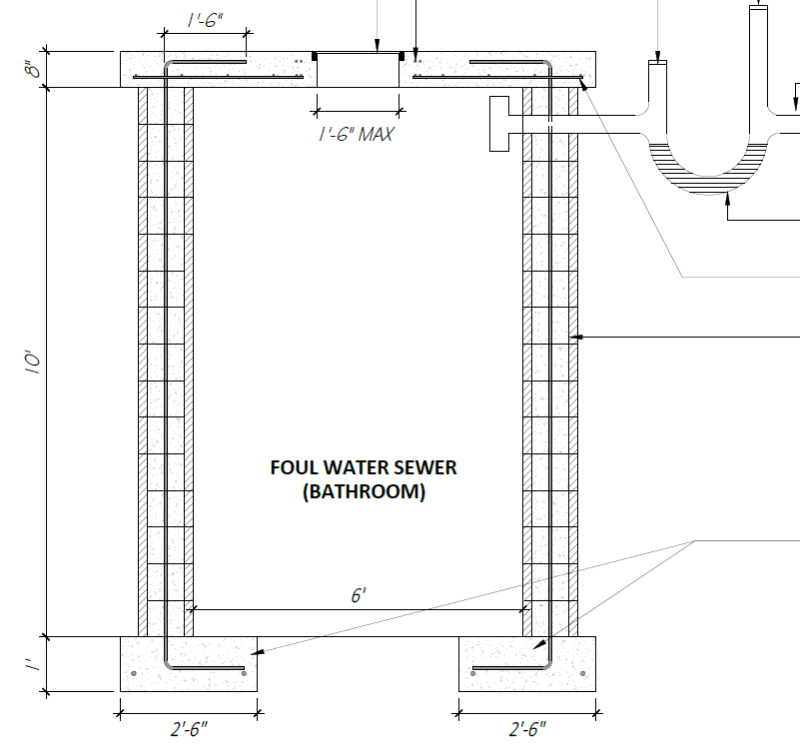psychedomination
Structural
Hi there,
I while ago I designed a cesspit for a client.
Where I am from these are very common for all houses/small buildings and typically they are around 6’ deep. The local building code allows these to be built as unreinforced CMU block walls. The walls are typically staggered 2” every other course to provide weep holes for the sewage to slowly seep out, along with an open bottom/foundation to allow natural seepage. However, from an engineering perspective, I can’t get the tank walls to work when it is that deep without reinforcement (although I guess it must work if they have been doing it that way for XXX years with no recorded failures). In that scenario, I am assuming the walls would be acting more as a gravity wall and not a cantilever type wall that can take bending.
For my project, the cesspit was even deeper at 11’8” below grade. For the wall stem, I called for 16mm bars at 8” c/c in 12” filled CMU block. There isn’t a concern about large vehicles constantly going over the pit in the area but I thought it would make sense to allow for a small surcharge for construction equipment and material storage.

Fast forward a few weeks, I got a call from the client stating that the contractor is asking why I specced 16mm @8” cc because they would like to put 12mm bars at 16” c/c.
I wasn’t too fussed by the comment and told them to stick with the original rebar that was called for. I wasn’t going to waste time/lose sleep on a few extra rebar in a tank that’s only 8’x6’ in plan area.
However, it does have me thinking about future projects if I can be less conservative and what is the best practice.
Although it’s a tank, when I was doing the design, I considered the wall as a propped cantilever retaining wall in the permanent state (propped after the top slab is poured) and as a cantilever retaining wall in the temporary state (in case the contractor backfilled prior to pouring the top slab). In all cases, I assumed the tank was empty.
Seeing as this is a tank, there will most likely be additional moment distribution to the tank wall corners that I didn’t consider. Is there any guidance that anyone can share regarding the design of CMU block tank wall design?
I do have the PCA ‘Rectangular Concrete Tanks’ document but would that be applicable for CMU block tank walls as well? The CMU walls don’t tend to have horizontal reinforcement.
Any advice/guidance would be greatly appreciated.
I while ago I designed a cesspit for a client.
Where I am from these are very common for all houses/small buildings and typically they are around 6’ deep. The local building code allows these to be built as unreinforced CMU block walls. The walls are typically staggered 2” every other course to provide weep holes for the sewage to slowly seep out, along with an open bottom/foundation to allow natural seepage. However, from an engineering perspective, I can’t get the tank walls to work when it is that deep without reinforcement (although I guess it must work if they have been doing it that way for XXX years with no recorded failures). In that scenario, I am assuming the walls would be acting more as a gravity wall and not a cantilever type wall that can take bending.
For my project, the cesspit was even deeper at 11’8” below grade. For the wall stem, I called for 16mm bars at 8” c/c in 12” filled CMU block. There isn’t a concern about large vehicles constantly going over the pit in the area but I thought it would make sense to allow for a small surcharge for construction equipment and material storage.

Fast forward a few weeks, I got a call from the client stating that the contractor is asking why I specced 16mm @8” cc because they would like to put 12mm bars at 16” c/c.
I wasn’t too fussed by the comment and told them to stick with the original rebar that was called for. I wasn’t going to waste time/lose sleep on a few extra rebar in a tank that’s only 8’x6’ in plan area.
However, it does have me thinking about future projects if I can be less conservative and what is the best practice.
Although it’s a tank, when I was doing the design, I considered the wall as a propped cantilever retaining wall in the permanent state (propped after the top slab is poured) and as a cantilever retaining wall in the temporary state (in case the contractor backfilled prior to pouring the top slab). In all cases, I assumed the tank was empty.
Seeing as this is a tank, there will most likely be additional moment distribution to the tank wall corners that I didn’t consider. Is there any guidance that anyone can share regarding the design of CMU block tank wall design?
I do have the PCA ‘Rectangular Concrete Tanks’ document but would that be applicable for CMU block tank walls as well? The CMU walls don’t tend to have horizontal reinforcement.
Any advice/guidance would be greatly appreciated.

![[ponder] [ponder] [ponder]](/data/assets/smilies/ponder.gif) ]
]